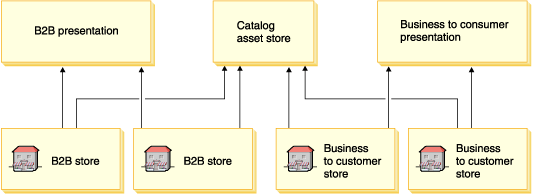
Asset stores
To facilitate the creation and management of multiple stores such as customer-facing stores and proxy stores, WebSphere Commerce implements asset stores. Asset stores are collections of sharable resources (business artifacts, business processes and storefront assets) that can be leveraged in other stores. An asset store is typically composed of the assets that can be used by multiple stores, but is in itself not a fully functional store and does not conduct business transactions.
In WebSphere Commerce an online store is the place where all transactions for your online business occur. All online stores created with WebSphere Commerce include at least one of the following types of assets:
- Storefront
- The external portion of your store, or the portion that displays to your customers, is known as the storefront. The storefront consists of Web assets such as HTML pages, JSP files, style sheets, images, graphics, and other multimedia file types.
- Business logic
- The portion of your store that processes customer requests, including the commands and any customized code, is known as the business logic.
- Store data
- The data assets that compose your store. In order to operate properly, a store must have the data in place to support all customer activities. For example, in order for a customer to make a purchase, your store must contain a catalog of goods for sale, shipping methods and shipping charges, taxes, and the inventory to fulfill the request. Your store must also have methods for authorizing and processing payments.
If a store contains all three types of assets, that is storefront assets, business logic, and store data, it is a fully operational store. If a store contains only a subset of the assets, that is it contains storefront assets and business logic, or store data and business logic, or just store data, it is known in WebSphere Commerce as an asset store.
WebSphere Commerce provides sample catalog asset stores and storefront asset stores. The following diagram illustrates the relationship between stores and a catalog asset store.

WebSphere Commerce implements asset stores in the following business models:
- Extended sites
- Demand chain
- Supply chain